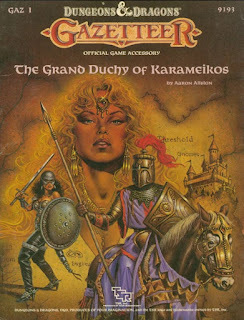Retrospective: The Grand Duchy of Karameikos
 I was a TSR fanboy, but I was also something of a snob when it came to products released under the banner of plain old Dungeons & Dragons, which is to say, D&D minus the adjective "advanced." To me, that was "kiddie D&D" and unworthy of my attention. At the same time, I had my weaknesses and one of them was new campaign settings. So, when TSR released the first module in its line of D&D Gazetteers in 1987, I was more than a little intrigued, despite its connection to non-advanced D&D.
I was a TSR fanboy, but I was also something of a snob when it came to products released under the banner of plain old Dungeons & Dragons, which is to say, D&D minus the adjective "advanced." To me, that was "kiddie D&D" and unworthy of my attention. At the same time, I had my weaknesses and one of them was new campaign settings. So, when TSR released the first module in its line of D&D Gazetteers in 1987, I was more than a little intrigued, despite its connection to non-advanced D&D.My contradictory interest in The Grand Duchy of Karameikos was rooted in the fact that it was part of the "Known World" (later Mystara) sketched out in The Isle of Dread, a module I'd used to good effect when it was first released (again, despite my elitist suspicion of D&D – my standards were frustratingly inconsistent in my youth). I was also curious to see what Aaron Allston might do with the region first mentioned in the D&D Expert Rules, since the module boasted of providing "a complete historical, economical [sic], geographical, and sociological overview" of the Grand Duchy and its inhabitants. It was a tall order, to be sure, but the thickness of the supplement – 64 pages – and its inclusion of a "full-size, four-color map" of Karameikos and two of its major settlements gave me hope that it would be worth the purchase.
The module is divided into two sections. The first part is the gazetteer proper, covering the history, politics, and society of the Grand Duchy, including descriptions of its most important locales and NPCs. The second part, which is very short, provides ideas for adventures set in and around Karameikos for a variety of levels of play, from 1st level all the way to 36th. Together, the two sections provide a lot of information for the referee to digest, but they also include lots of inspiration too. Scattered throughout the module are numerous maps for use in play, like typical taverns and manor houses. This is in addition to the large, poster-sized map of the Grand Duchy, its capital city of Specularum, and the frontier town of Threshold.
Riffing off the details first put forward in the excellent adventure, Night's Dark Terror, which is set in Karameikos, Allston paints a portrait of the Grand Duchy as an analog to one of the eastern European satellites of the medieval Byzantine Empire (here represented by the Empire of Thyatis). Karameikos is rough and tumble sort of place that is slowly in the process of becoming more settled and orderly, but with enough enemies, both internal and external, to keep it interesting for D&D adventurers. In many ways, Karameikos is a nearly perfect setting for the game, since it's just settled enough to provide bases from which characters can operate and just wild enough that there's plenty of scope for exploration (and looting). The place has a frontier feel to it that makes it very easy for the PCs to carve out domains of their own under the suzerainty of the Grand Duke.
Of course, that also means that Karameikos is a bit on the vanilla side. Beneath the Slavic veneer of the place, it's your typical fantastic medieval realm with the full panoply of D&D flourishes: knights, monsters, allied demihumans, thieves, etc. There's likewise a faux Christian Church to which clerics can belong, in addition to dark, secretive cults up to no good. This isn't necessarily a bad thing. As I mentioned above, it's a very solid set-up for a standard model of a D&D campaign and there's enough information here to save the referee a lot of trouble when it comes to framing his adventures. However, if you're hoping for something different, or even just off the beaten path, you'll likely be disappointed.
And I was. I didn't hate The Grand Duchy of Karameikos; that's too strong an emotion for a product like this. Instead, I was simply unimpressed and, as a result, avoided the other Gazetteer volumes that followed in its wake (with the exception of The Northern Reaches, released in 1988). I simply assumed that all the subsequent volumes would be similarly paint-by-numbers in their content – an assessment I would later learn was gravely mistaken and that would lead to my not reading the other volumes in the series until many years after the fact. Live and learn, as they say!
James Maliszewski's Blog
- James Maliszewski's profile
- 3 followers



